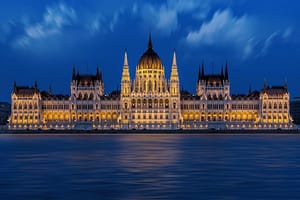Széchenyi Thermal Baths
Thanks to its abundance of thermal baths, Budapest has earned the nickname ‘City of Spas’. There are many great baths in the Hungarian capital, but Széchenyi gets our vote for its stunning architecture and open-air bathing: visitors can relax in two outdoor thermal pools, surrounded by neo-Baroque and neo-Renaissance architecture.
Bude Castle
A UNESCO World Heritage Site, the construction of Buda Castle first began in the 13th century, and since then the building has undergone a number of architectural changes. Today, it’s a combination of the medieval, Baroque, Baroque Revival and modernist styles, and its grounds provide an impressive lookout point over Pest. It’s also home to the Hungarian National Gallery, an art museum showcasing local artists.
Hungarian State Opera House
Located on the historic Andrássy Avenue, the Hungarian State Opera House is widely viewed as one of the world’s most beautiful. The building has played host to world-class operatic performances as well as ballets, concerts and more; for anyone not wanting to catch a show, guided tours of the building take place on a daily basis, with the option to add on a ‘mini-concert’.
From July 2017 – May 24, 2018 the Hungarian State Opera House will undergo renovations in its auditorium, meaning there will be no performances during this time. However, the building will remain open for tours, and the Opera Shop and Café will also stay in business.
St Stephen’s Basilica
Along with the Hungarian Parliament Building, St Stephen’s Basilica claims the title as the tallest building in Budapest, standing at 96 meters tall. Construction was completed in 1905, with the Roman Catholic Basilica built in the neoclassical style. Its interior is free to visit (donations are welcomed), while its central dome is home to a panoramic lookout point which is well worth the small fee.
Dohány Street Synagogue
Europe’s largest synagogue (and the world’s second largest), The Great Synagogue was built in the Moorish Revival style in 1859. During WWII, the building suffered damage and misuse; it wasn’t until the 1990s that it would be restored to its former glory. Within the Synagogue’s complex, visitors will find the Jewish Cemetery – the resting place of thousands who died during the Holocaust – and the Raoul Wallenberg Memorial Park, dedicated to the Swedish diplomat who worked to save thousands from Nazi and Arrow Cross persecution.
Hungarian Parliament
Hungary’s Parliament Building was built in 1902 and is the third largest parliament building in the world. Standing on the banks of the river Danube, in Pest, it’s an impressive edifice built in the Gothic Revival style and is worth visiting both for its stunning architecture and political significance. Tours of the building’s interior are available in a number of languages, while outside there’s a recently renovated square and a monument to the victims of the 1956 revolution in Hungary.
Fishermen’s Bastion
A fairytale castle on the Buda side of the city, the Fisherman’s Bastion is a lookout point affording stunning panoramic views across the Danube towards the Hungarian Parliament Building and Pest. Built in 1902, in the neo-Gothic and neo-Romanesque styles, it’s an incredibly photogenic part of the city and is free to visit.

